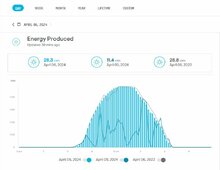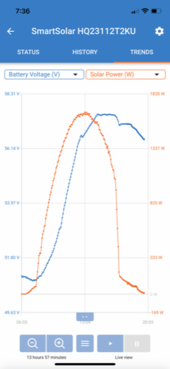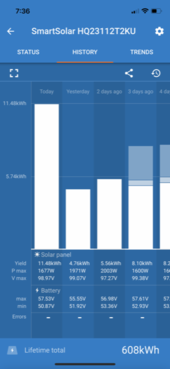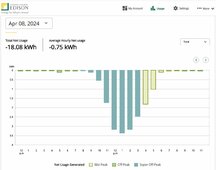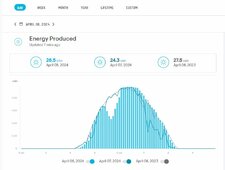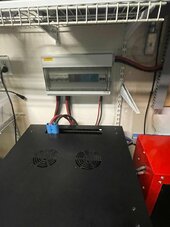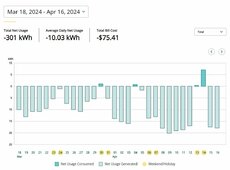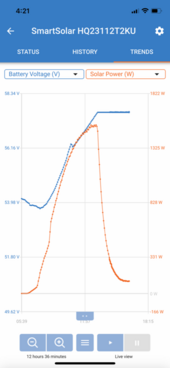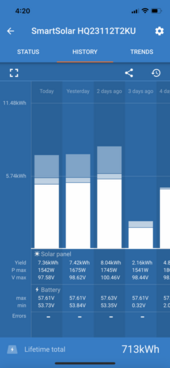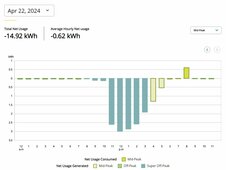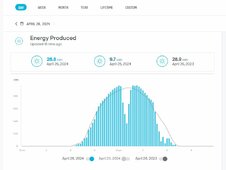GXMnow
Solar Wizard
- Joined
- Jul 17, 2020
- Messages
- 2,716
We had 2 days of poor production, and my battery got down to 51 volts, I have it stop grid support at 50.5, so it was about as low as I normally go.
The... For over 20 minutes before 6 am I had another one of those events where the current oscillated from charge to discharge. I really think it is the grid adjusting the voltage, which is why it seems to always happen when most people are asleep. It is certainly not anything I am doing. But the new firmware in the XW-Pro sure seems to make the oscillating look bad.
But now today is sunny and cool. The Enphase system is rocking, sitting at 3,900 watts and clipping for nearly 2 hours and the battery was nearly full before 2 pm. So I am trying a small experiment. I shut down my PLC and I set the XW to export at 14 amps. Because of all the power coming in from the Enphase system, it's only pulling 400 watts from the battery while the Victron controller is still pushing in over 1,600 watts. I'll kick it up even a little higher. Okay, now I am pushing 15 amps back to the main panel, with 680 watts coming from the Victron and still nearly 1,000 watts still charging into the battery bank.
I am really curious to see how many watt hours my DC array can produce, so I am pushing a bunch into the grid. I am making sure I don't exceed my 16 amp limit though. I have been watching it for a bit now. With the PLC off, I am manually adjusting the power flow. It's giving me some ideas on how to improve the PLC control routine. I need to add a DC power meter on the input from the Victron controller. I wonder if I can read the data directly from the Victron with my PLC? Once I know the DC solar coming in, I could set it to export a set percentage of it once the battery is above a certain state of charge.
The export from battery I am doing is just enough that the voltage is no longer climbing and the Victron should stay in bulk. It's already passing 9 KWHs and it is beating the Enphase system performance. At 3:35 the DC system hit 10.1 KWH or 5.05 sun hours, where the Enphase system just hit 22.2 KWH or just 4.625 sun hours. The Victron controller is doing great. At no time did the BougeRV controller ever beat the Enphase system.
The... For over 20 minutes before 6 am I had another one of those events where the current oscillated from charge to discharge. I really think it is the grid adjusting the voltage, which is why it seems to always happen when most people are asleep. It is certainly not anything I am doing. But the new firmware in the XW-Pro sure seems to make the oscillating look bad.
But now today is sunny and cool. The Enphase system is rocking, sitting at 3,900 watts and clipping for nearly 2 hours and the battery was nearly full before 2 pm. So I am trying a small experiment. I shut down my PLC and I set the XW to export at 14 amps. Because of all the power coming in from the Enphase system, it's only pulling 400 watts from the battery while the Victron controller is still pushing in over 1,600 watts. I'll kick it up even a little higher. Okay, now I am pushing 15 amps back to the main panel, with 680 watts coming from the Victron and still nearly 1,000 watts still charging into the battery bank.
I am really curious to see how many watt hours my DC array can produce, so I am pushing a bunch into the grid. I am making sure I don't exceed my 16 amp limit though. I have been watching it for a bit now. With the PLC off, I am manually adjusting the power flow. It's giving me some ideas on how to improve the PLC control routine. I need to add a DC power meter on the input from the Victron controller. I wonder if I can read the data directly from the Victron with my PLC? Once I know the DC solar coming in, I could set it to export a set percentage of it once the battery is above a certain state of charge.
The export from battery I am doing is just enough that the voltage is no longer climbing and the Victron should stay in bulk. It's already passing 9 KWHs and it is beating the Enphase system performance. At 3:35 the DC system hit 10.1 KWH or 5.05 sun hours, where the Enphase system just hit 22.2 KWH or just 4.625 sun hours. The Victron controller is doing great. At no time did the BougeRV controller ever beat the Enphase system.



